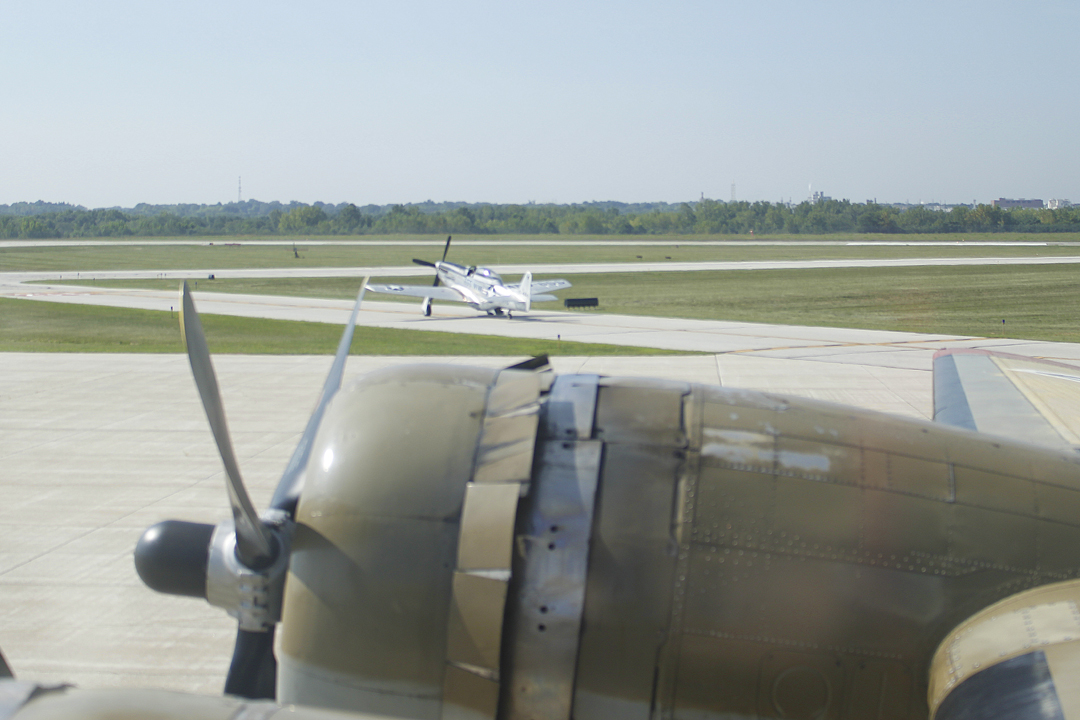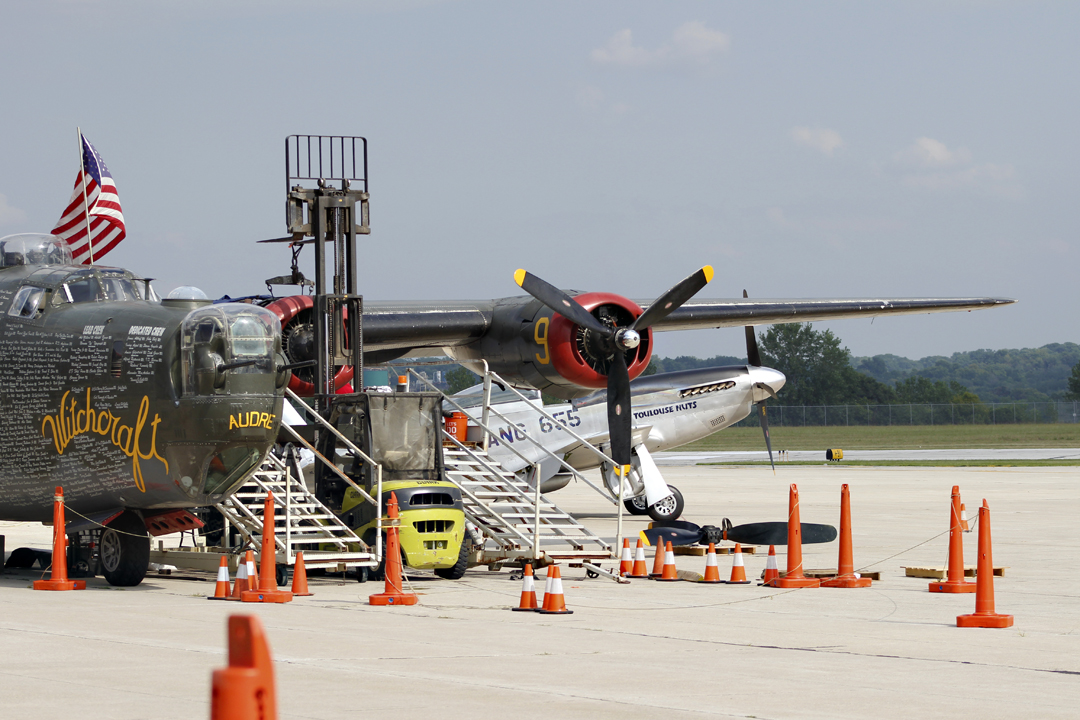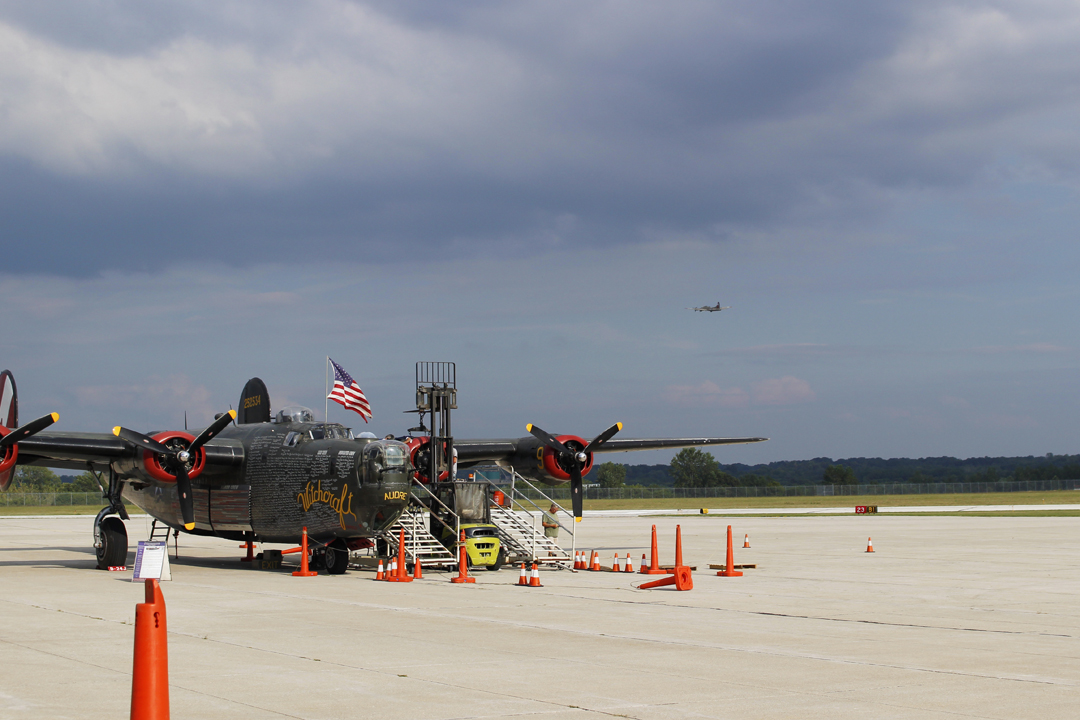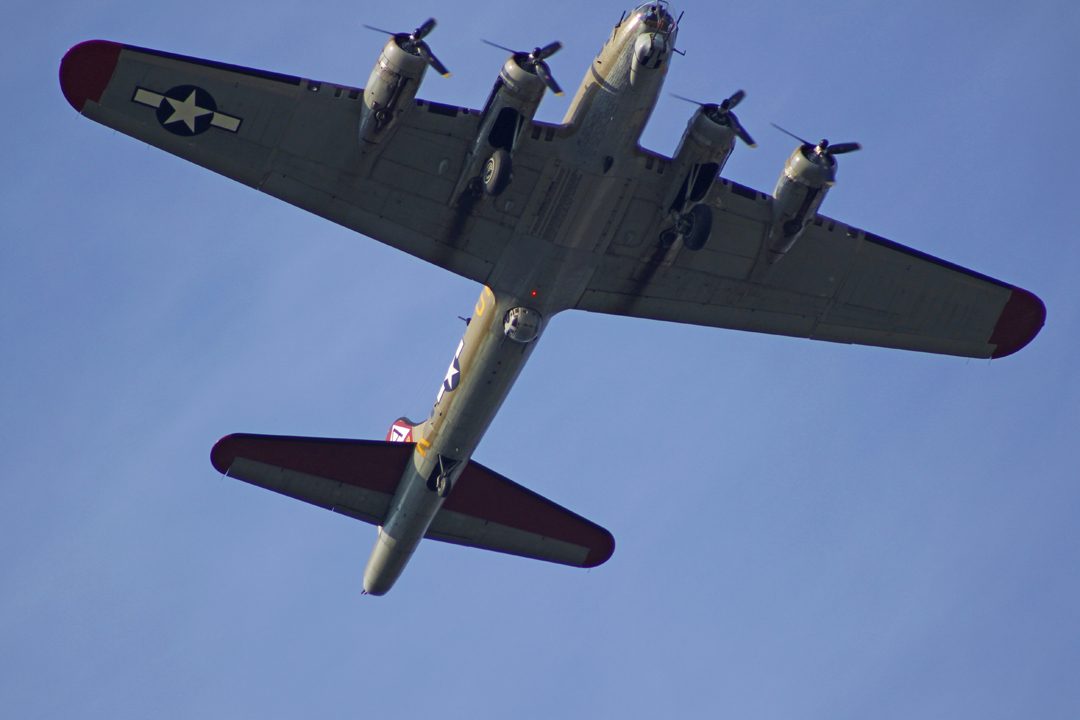Ron and I went 'round the airport on Tuesday morning, while it was still relatively cool, air temp-wise. The afternoon would prove much warmer, especially with so much concrete underfoot, but that's later. A little after nine in the AM, we could see Nine-0-Nine dropping down to make its approach after a flight as Ron drove us across campus. "Hey, there's one now!" I said, pointing through the windscreen. Again, a little spooky to see a B-17 flying low and slow across our airspace. We were walking toward the terminal building from the land side as the 17 approached from the air side; I got my camera out a little earlier than I expected:
 web.jpg?1498702820861)
In the terminal, Collings had a variety of memorabilia for sale, as well as a check-in for people who wanted to fly along. I asked if there were still spaces available - of course I did, telling myself that there wouldn't be but that would be O.K. 'cause I shouldn't spend the money but naturally there were spaces still, and I signed on - and getting one for around six o'clock that evening. The other visitors were already stacking up behind the crowd control barricades on the air side when we walked out. Nine-0-Nine as parked just beyond, her ground crew finishing up before letting the growing throng out to walk around and through:
 web.jpg?1498702822739)
.jpg?1498702821602)
The B-25 Tondelayo (above) and the B-24 Witchcraft (below) facing each other past the terminal.
 web.jpg?1498702819803)
In fairly short order the three bombers were encircled, with queues forming for walk-through viewing. There would be larger crowds in the afternoon, but even by about ten-thirty, the visitors were plentiful. Alas for anyone who wanted to go up, the 24 was experiencing some kind of engine trouble. The port-side inboard (the No 3, right?) would see mechanics in attendance shortly after the above photo was taken (note the orange cones there warning off anyone not supposed to be in the immediate area under that nacelle). I think that's why Witchcraft is sporting the flag: it's not moving, so get the colors on!
Now, I don't want to gainsay the B-24; technically speaking, it was superior to the B-17 in many ways: higher, faster, more payload, produced in greater numbers by something like 5,000 "units." But (there's that "but" you can expect when someone begins by stating "I don't want to gainsay") this plane never caught my attention in the same way. I wasn't going to skip it or the 25, though I could have; "There are other planes out here!" I kept reminding myself.
.jpg?1498702823950)
 and Toulouse web.jpg?1498702826504)
Above left: arty shot! The starboard vertical stabilizer of Tondelayo. At right, Toulouse Nuts returning from its flight: photo op anyone? I wondered that no one else thought to try some context angles. Well, maybe someone did, but not while I was watching. I would have liked a clear shot past the 25 here, but you take the photo you can sometimes, and the 51 didn't stay still waiting for anyone.
Yes, I spent a deal of time wandering about Nine-0-Nine before queuing myself for the interior. Ron had already gone through before me, whilst I meandered between planes, looking for "the next shot." What I hadn't considered, though it came clear enough as I went 'round, is that there really are not that many different ways you can shoot a plane when you're stuck with your feet on the hardstand, and fifty people lined up next to it or wandering around it as I was. I did my best, though.
 web.jpg?1498702823785)
 web.jpg?1498702824304)
Above left: the starboard outside engine of Nine-0-Nine. Above right: arty shot! Catching the sunlight bouncing off the starboard side of the fuselage. Those are "real deal" .50's in the top turret, and elsewhere as can be seen below. I can't speak to their operation, but I wouldn't want to stake any money on their condition.
When I did climb up the (convenient for visiting patrons) step ladder, I wasn't sure what to expect, honestly. The last time I'd been within touching distance of a B-17, it wasn't "open" for tours, just walk-arounds. I knew it would be tight, and it was, though I had no concern for that. I wouldn't say that the interior was comfortable, no - far from it - but I was fairly at ease moving through; I was comfortable with the interior.

Once in a lifetime shot? Maybe. But in haste, the focus was a little off: 51's don't wait around for you! Toulouse Nuts taxis for another flight, as seen from inside Nine-0-Nine.
 web.jpg?1498702827638)
 web.jpg?1498702830334)
Above left: the .50 on the starboard side of the bombardier's position. At right: looking forward through the bomb bay from the hatch to the radio room. That narrow metal "plank" to the right and below the "payload" is the access-way from the cockpit to the aft sections of the plane.
Below, looking aft: part of the radio room equipment with the top of the ball turret and the turret's suspension beyond the hatchway.
 web.jpg?1498702827877)
Nine-0-Nine is of the last variant of the B-17 line, the "G" series, which included the "chin turret" and featured perspex at the waist gunners' positions (which can be just barely glimpsed beyond the ball turret at left).
Beyond the other, perhaps more widely held symbolic aspects of the B-17, I also find its overall design more satisfying than many other - well, planes. I suppose I could say that I appreciate the fact that it was designed, and not simply engineered. But then, it is a product of the era when it was designed: it was the Depression, yes, but also the decade of the Streamlined Modern or American Moderne, when the industrial designers had their day and their ideas touched almost everything that was manufactured in the U.S. Whether airplanes or pencil sharpeners, automobiles or ash trays, heavy bomber prototypes by Boeing included.
Below: Model 299, or NX 13372, Boeing's entry into an Army Air Corps' competition for a new heavy bomber, 1935.

It's true that any plane has its aesthetic, and wind tunnel-testing showed that "stream lining" did aid in the airframe being "slippery" and reducing drag, thereby increasing speed. It would be many decades until computer aided-design and -testing would show just how much angle could be had in a body that moved through air and still have low drag, but many of the planes designed just prior to or during the war years would follow more of a Bauhaus (if you will) ideal: form follows function. If the function is to move fast through the sky and shoot at things, the form will follow. The P-51 is a good example of this. To my eye those planes, however attractive (and many are indeed attractive craft) lack the sense of styling that was imparted on 299 and its successor 17's, even if the Moderne "gun blisters" of 299 were jettisoned in favor of more functional gun placements. The vertical stabilizer was pretty radically re-designed, too, for - well - better stability, but the essential airplane is there as of 1934-35.
 web.jpg?1498702830047)
In the afternoon, after checking in for my flight (strange to think of it in those terms) I wandered about some more. The visiting crowd had grown, and included many more veterans of some foreign war or other. I spent some time chatting with a man who had served in Viet Nam (circa 1970) and we spoke of the comradeship felt by men in war (experience more on his part of course) and what "Hollywood" gets right sometimes. He told me that he was acquainted with Collings (of the eponymous Foundation) when they were both students at Purdue University. Back then, in the ago, Collings was meticulously reconditioning an old car, in a forward nod to the attentions the Foundation would expect of its planes' rehabilitation and preservation.
As the visitors' attentions were elsewhere for a time, I availed myself of a walk-through of the 24. Form follows function? If you want more payload (that is: "bombs") but you don't want the plane to be too big for the engines available, then something is going to be lost. In this case, it's the space available for the crew. Big as they were for their era, there wasn't a lot of space for the men inside - just enough for them to do their duty, really - but the inside of the 24 made the interior of the 17 seem luxurious.
 web.jpg?1498702831162)
 web.jpg?1498702831342)
Above left: inside the bomb bay, with myriad control lines running through and one of the control hydraulic tanks. At right: the view through the radio room to the cockpit.
Some time during the afternoon, Toulouse Nuts returned from one of her flights:
 web.jpg?1498702834337)
and was parked beyond Witchcraft, making for a nice shot, I thought. The names scripted on the starboard fuselage of the 24 are those of the people who have made some major contribution to the B-24's continued flying condition. The same can be seen on the starboard side of the 17 in the shot on the page header.

 web.jpg?1498702835033)
Nine-0-Nine from under the wing of Witchcraft, with some of the afternoon's visitors, 'cause I just gotta' take another photo of the 17.
After five PM, only the flying patrons were allowed beyond the barricades. The props were turned by hand first (to circulate the oil through the engine) as the rest of us made our short trek out of harm's way. Tondelayo's engines were fired up first in a blast of oil- and fuel smoke, followed by Nine-0-Nine's engines. For a moment, the air between them was smogged like Los Angeles of old, but the breeze and the prop wash cleared it out quickly.
.jpg?1498702835260)
Here, Tondelayo taking out its consign of visitors. It went up but once on this Tuesday afternoon. Below: just at take-off.
.jpg?1498702834760)
.jpg?1498702845095)
I am, frankly, impressed that any of the photos taken of the planes flying about attained a fairly good focus. The zoom lens, while not as long or heavy as a proper telephoto is yet somewhat unwieldy when the subject is in such motion as an airplane taking to the air.
Tondelayo, wheels up and off on her circuit.
As Nine-0-Nine warmed her engines, the smart phones appeared in profusion, though, really, there wasn't much to see at that point. As she turned, the power of the prop wash was immediately evident, as on-lookers were buffeted and had to lean into the wind, hats were blown away, and the smart phones cradled. A moment later, the 17 was rolling along the taxiway:
 web.jpg?1498702838721)
Below: Nine-0-Nine at the beginning of her circuit, while Witchcraft will shortly have the No 3 engine removed entire.

While Nine-0-Nine was off on her circuits (she would do four tours that evening), people lingered in the viewing area, and other aircraft came and went. Tondelayo was returned to her "spot" opposite Witchcraft after her tour, and the view brought my camera. One boy of about seven years was waiting with his father for the 17 to return, and watched one of the Purdue Aviation planes taxi past on her way to the hanger for the night. The father asked after the little plane, but the boy, rather disdainfully for one of his age, referred to it as a "practice plane!"
Below, one of the "practice planes" taxis beyond Tondelayo.
.jpg?1498702841572)
With Nine-0-Nine going and coming, I only had to wait before more chances behind the lens. At this time of afternoon, the ambient air temperature had climbed to the mid 80's, and the humidity had gone up noticeably. Standing in the viewing area offered no escape from the sun, and at moments I thought "just working on my tan!"
Below: arty shot! Yes, that sunlight slanting down across the clouds to glint off the fuselage with the masses of clouds overhead - of course! The lack of perspex over the radio room is plainly shown here as the dark oblong in the middle of the dorsal ridge. That space will prove to be a favorite of the passengers on my flight, and with good reason.
 web.jpg?1498702838787)
 web.jpg?1498702839142)
 web.jpg?1498702841708)
When the 17 returned from her circuit, her path came south-bound to pass right over the terminal, then beyond the airport all together before making a westard sweep to come back to the runway. Knowing this, I passed the interval before my flight on the land side north of the terminal, waiting for the bomber to cross my view from the ground. I whiled the minutes taking photos of other things in the vicinity, but kept an eye out to the northern reaches of sky. When the plane appeared it was but a wide, short silhouette shimmering in the still-rising heat of the afternoon. I had a pretty good idea that a decent photo of the plane as it passed overhead was maybe a slim chance, but I wasn't going to miss that chance, no sir! What I couldn't quite manage, while twisting myself along with the on-coming flight and focusing the lens, was to remember to roll the zoom out, so the framing got a little tighter than I thought it would:

Then I was back through the terminal to the hardstand, waiting to make my own walk out.
TUESDAY: at the terminal
